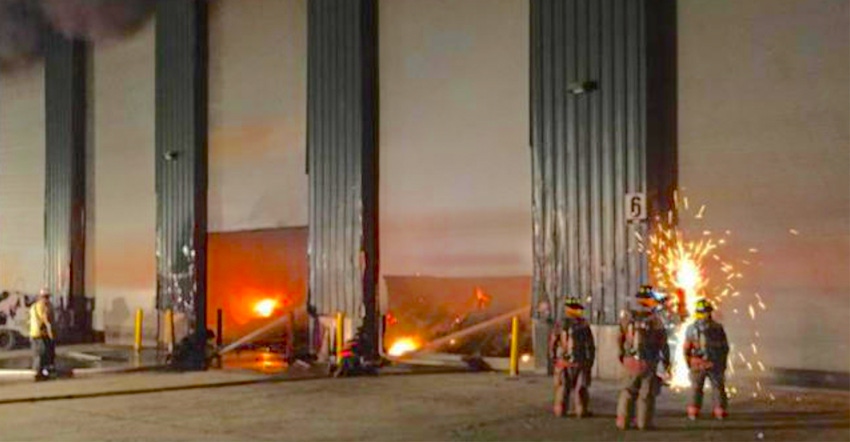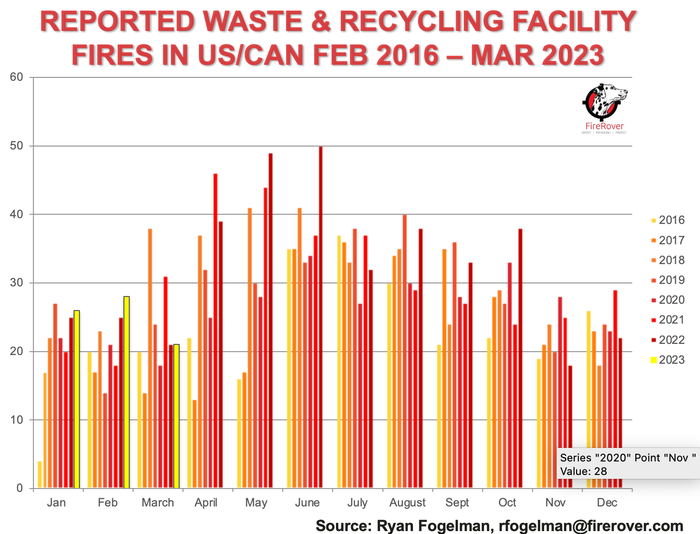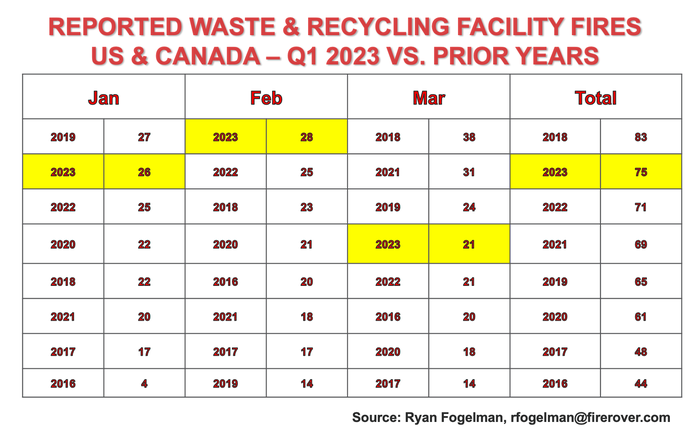Investing in new technology or infrastructure comes with a cost, but a fire in your waste and recycling operation can potentially come at a higher price tag when all is said and done. Therefore, it’s important to look at your budgets and apply for available grants to better keep your facilities and employees safe.

Investing in new technology or infrastructure comes with a cost, but a fire in your waste and recycling operation can potentially come at a higher price tag when all is said and done. Therefore, it’s important to look at your budgets and apply for available grants to better keep your facilities and employees safe.
In this month’s column, I not only highlight recent fire data but also useful information on how to find and apply for grants.
January, February and March 2023 Fire Data
As we come off a record year for reported fires at our waste and recycling facilities, highlighted in my recently released annual report, "Waste & Recycling Facility Fires Annual Report," the good news is that March’s reported fires were down from their seven-year trend. But unfortunately, January and February of this year were the second worst and worst since I began reporting this data in 2016, respectively. Of the 75 reported fire incidents in January, February and March, 32 occurred in waste, paper and plastic facilities; 24 occurred at scrap recycling facilities; five each occurred at organics facilities and hazard material recycling facilities; four occurred at rubber recycling facilities; three occurred at electronic recycling facilities; and two occurred at construction and demolition recycling facilities. At Fire Rover, we had a very busy three months and responded to more than 500 fire incidents at our clients’ facilities.
 '
'
2023 Compared to Prior Years

When comparing 2023 numbers to the historical average, Q1 of this year only comes in behind 2018, the year of the global lithium-ion battery wave, from an incident perspective. When compared to last year, 2023 had four fewer incidents, which is positive if we have any hope of reversing the trend from 2021 and 2022 as the worst years on record for fire incidents at our waste and recycling facilities. As you can see in the graph above, the trend of incidents has been steadily getting worse for most years outside of 2020, which included the start of the global pandemic.
Municipalities vs. Public Companies
When we brought our Fire Rover solution to the waste and recycling market in 2015, we were fortunate to have a few early adaptors believe in and pilot our solution. The reality is that almost all those early adaptors were private companies. We had interest from municipally owned solid waste and recycling facilities, but their municipal counterparts made it difficult for these organizations to procure our solutions. To be frank, the key reason why we do not have more municipal customers is cost. Municipalities tend not to have the flexibility in their budget for installing a system such as ours because many must wait for a new budget cycle to plan for procuring a Fire Rover system, unless they have the flexibility in their procurement policies and budget to spend on installing new infrastructure or technology (not limited to Fire Rover’s). After all, municipally owned and managed facilities may not be operating with an eye toward profits like private facilities, and their boards tend to be more conservative. Additionally, municipality's facilities tend to be protected by property insurance grouped into a bundle of government assets, so the pain they feel in insurance rates tends to take longer to hit the market than their private company counterparts.
First and foremost, rightsizing their protection is essential. Just like how a materials recovery facility will install equipment sized appropriately for its current and future processing needs, we do the same to customize a solution for our customers. Adding supplemental equipment to an existing fire protection system or suggesting the most effective options placed at the most-risk locations throughout the facility is imperative. We dig deep into phases of expansions and how best to provide protection before and after their growth occurs.
During our initial discussions, it is inevitable that the question of whether there are federal or state grants available to help with the cost. Are grants available? Yes. It is important to note that our solution addresses issues that lie at the intersection of several key industries and topics, including public safety, fire protection, solid waste management, recycling and environmental protection, among others. When it comes to seeking and applying for grants for one of our solutions, it is important to exhaust all available options within these topics.
How Does It Work?
If a municipality reaches out to Fire Rover for assistance with applying for a grant, they can expect that we will help them however we can. We will provide a quote for installation, which will include a description of the solution, site layout, budget and description of their recommendation options. If needed, we will engage one of our fire engineering firms to help with providing the stamped designs and/or variance documentation. All of these can be included as appendices and/or inform the body of the application. We also work with a few extremely knowledgeable grant writers who the municipalities can opt to work with. These grant writers are already familiar with the solid waste industry and Fire Rover’s solution, and if given sufficient time leading up to the submission, we can all work together to customize narratives to incorporate into a grant application.
What Grants Are Available?
The answer depends on several factors. First and foremost, where is your facility located? Some states are particularly keen to help fund new technologies and infrastructure in public safety, fire prevention, waste diversion, battery recycling/storage, resilience, environmental justice and pollution prevention, among others. State agencies and departments, such as those that oversee environmental protection, natural resources and energy, are good places to start. If your facility is within an area designated as ecologically sensitive, at a heightened risk for wildfires or within an environmental justice area, there may be more funding opportunities available, particularly at the federal level.
Secondly, how much additional funding does the municipality need? Depending on the size and complexity of your facility, our solution costs will vary. Local, state and federal grants can have funding limits from several thousand to several million dollars per project; some require matching funds, while others do not. It’s all about finding the ones that are the right fit for your community and submitting winning grant proposals. Fire Rover maintains a list of upcoming grant opportunities and can recommend grant writers to municipalities that inquire.
Conclusion
As much as the industry, both private and public, is doing its best to educate the public on hazards of disposing of potential fire hazards in our waste and recycling streams, we are still having fires on a daily basis and, unfortunately, catastrophic losses. Our solution, among other best practices, is on the frontlines fighting that fight with extremely positive results. Whether you are a government agency or a private company, all operators should have support from our government to help with the fire problem that is AT NO FAULT OF THE OPERATORS. I hear our national congressional figures talk all the time about how they fully support “recycling,” but the fact is they do not understand the real issues we are facing on the frontlines. This battle to help protect our local waste and recycling operations must be fought at a local level, and we are here to help our clients with that fight.
If you are attending WasteExpo 2023 and would like to learn more about what operators are doing to help fight their fires, attend the “Lithium-ion Battery Fires Are Everywhere: An Overview of the Problem and Solutions” education session on Monday, May 1 at 9:45 a.m. CT, where the first 50 attendees will receive a FREE printed copy of my latest annual report. If you cannot make the session, I will be available in the Fire Rover Booth #816 during the exhibit hall hours of the show. Hope to see you in New Orleans!
Ryan Fogelman, JD/MBA, is vice president of strategic partnerships for Fire Rover. He is focused on bringing innovative safety solutions to market, and two of his solutions have won the distinguished Edison Innovation Award for Industrial Safety and Consumer Products. He has been compiling and publishing the “Reported Waste & Recycling Facility Fires In The US/CAN” since February 2016 and the “Waste & Recycling Facility Fires Annual Report.” Fogelman regularly speaks on the topic of the scope of fire problems facing the waste and recycling industries, early detection solutions, proper fire planning and early-stage fire risk mitigation. Additionally, Fogelman is on the National Fire Protection Association’s Technical Committee for Hazard Materials. (Connect with Ryan on LinkedIn at https://www.linkedin.com/in/ryanjayfogelman or email at [email protected])
About the Author(s)
You May Also Like




